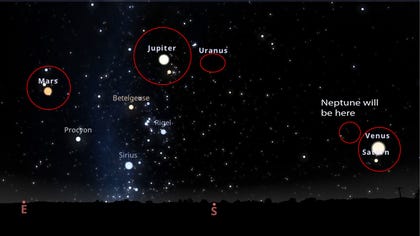Planets including Mars, Venus, Jupiter, Saturn, Neptune and Uranus can be seen together in the sky for the first month of 2025. You can start to see these six planets in the days leading up to January 21, 2025.
You may need binoculars or a telescope for this one. It includes the three furthest planets in our solar system.
Between sightings of the aurora borealis, the solar eclipse, supermoons and plenty of other cool phenomena, there’s been something in the sky to look at throughout 2024. It seems 2025 will have a strong start, too, with a planet parade just a few weeks into the new year. A planet parade is when several of our solar system’s planets are visible in the night sky at the same time.
There will be six planets visible this time around, including Venus, Mars, Jupiter, Saturn, Neptune and Uranus. The six planets will be visible in the days leading up to Jan. 21, 2025, and for about four weeks afterward. Mars, Venus, Jupiter and Saturn should be visible to the naked eye. You’ll need a high-powered viewing device like a telescope to spot Neptune and Uranus.
The best time to view the planets from the Northern Hemisphere will be just after sunset at around 8:30 p.m. local time. You still might be able to catch Venus, Saturn and Neptune on the horizon after that, but all three planets will be under the horizon by 11:30 p.m. to midnight depending on your location. After that, Mars, Jupiter and Uranus will remain visible for a few more hours with Mars finally setting just before sunrise.
Unlike prior parades, this one is set to last quite a while since the planets are in advantageous spots in the sky. You should be able to see all six planets nightly until the last week or so of February.
After that, the seven-planet parade will begin as Mercury will briefly join the others in the sky for a couple of days, turning this into a planetary parade of all seven planets in our solar system other than Earth. It will be difficult to see them all since Saturn, Mercury and Neptune will be quite close to the sun right at sunset, but they will be there
Will I need any special equipment to view the parade?
Technically yes. You’ll be able to spot Venus, Mars, Jupiter and potentially Saturn with the naked eye in opportune conditions. However, Neptune and Uranus are simply too far away to spot. Astronomers note that you’ll likely need a telescope with at least an 8-inch aperture at 50 times magnification to see Uranus and its rings, and 150 times magnification to see Neptune and its rings. If you’re so equipped, give that telescope a point at Saturn. At 25 times magnification, you’ll be able to see the crown jewel of our solar system in all its glory.
Standard space viewing rules also apply here. You’ll want to get away from the city, where light pollution can obfuscate your view. Even the suburbs may not be far enough away for many folks. If you’re planning a long drive out of the city and its surroundings, you’ll want to make sure it’s a clear night with as little cloud cover as possible.
If you’re headed out to see all seven planets at the end of February, you’ll have a particularly difficult task ahead of you as a few of the planets will be fairly close to the sun. You may want to invest in UV protection for your eyes and be particularly careful about where you point your telescope.



